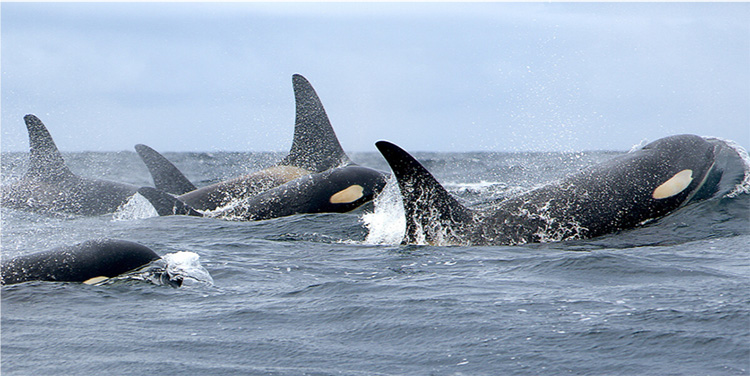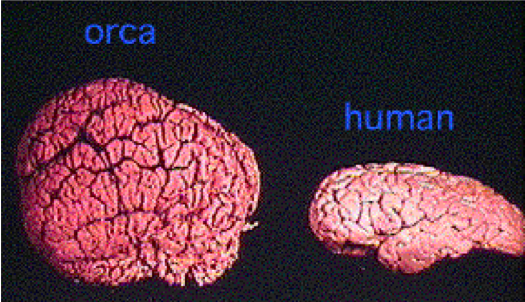Rights for the Southern Resident Killer Whales
Source: NOAA (http://www.afsc.noaa.gov/Quarterly/amj2005/divrptsNMML3.html)
By Michelle Bender and Darlene Lee
Earth Law Center is partnering with Legal Rights for the Salish Sea (Gig Harbor community group), the Nonhuman Rights Project and PETA to seek rights recognition for the endangered Southern Resident Killer Whale population and the Salish Sea.
A Brief Primer on Orcas
Most of us easily recognize the distinctive black and white coloring of Orca Whales. But did you know that they are the largest member of the 35 species in the oceanic dolphin family, which first appeared about 11 million years ago?[i] Considering Homo Sapiens have been on Earth just 200,000 years[ii], perhaps our perspective on these highly intelligent and social fellow Earthlings needs to evolve.
"Whales represent the most spectacularly successful invasion of oceans by a mammalian lineage," said Michael Alfaro, UCLA assistant professor of ecology and evolutionary biology. "They are often at the top of the food chain and are major players in whatever ecosystem they are in. They are the biggest animals that have ever lived. Cetaceans (which include whales, as well as dolphins and porpoises) are the mammals that can go to the deepest depths in the oceans.[iii]
Unlike other whales who have shrunk in size over time, Orcas have become larger over the last 10 million years. Also unlike other whales, they eat mammals, including other whales. "If we look at rates of body-size evolution throughout the whale family tree, the rate of body-size evolution in the killer whale is the fastest," Graham Slater, a National Science Foundation–funded UCLA postdoctoral scholar in Alfaro's laboratory said.[iv]
Contrary to their reputation in popular culture and the much-publicized attacks by captive Orcas, no recorded case of a free-ranging orca ever harming a human exists. Even when orca mothers are violently pushed away with sharp poles so their young can be wrestled into nets and loaded onto trucks, they have never attacked a human being.[v]
Types of Orca Clans
The IUCN reported in 2008, "The taxonomy of this genus is clearly in need of review, and it is likely that O. orca will be split into a number of different species or at least subspecies over the next few years." The three types include[vi]:
Resident: Feeding on fish and squid, these Orcas live in complex and cohesive family groups called pods. They visit the same areas consistently. British Columbia and Washington resident populations are amongst the most intensively studied marine mammals anywhere in the world. Transients and residents live in the same areas, but avoid each other.
Source: NOAA
Transient: The diets of these whales consist almost exclusively of marine mammals. Transients generally travel in small groups, usually of two to six animals, and have less persistent family bonds than residents. Transients vocalize in less variable and less complex dialects. Transients roam widely along the coast. Transients are also referred to as Bigg's killer whale in honor of cetologist Michael Bigg.
Offshore: These orcas travel far from shore and feed primarily on schooling fish and may also eat mammals and sharks. Offshores typically congregate in groups of 20–75, with occasional sightings of larger groups of up to 200. Little is known about their habits, but they are genetically distinct from residents and transients. Offshores appear to be smaller than the others.[vii]
Orcas have a brain part that humans don’t
Not only do they have their well-documented senses of humor and empathy and mischievousness, Orcas possess a paralimbic cleft which "may enable some brain function we can't even envision because we lack it," David Neiwert writes in Of Orcas and Men, his breathtaking survey of orca science, folklore, and mystery. "Scientists who examine their brains are often astonished at just how heavily folded these brains are."
The more wrinkles and folds a brain has, the more data it can handle and the faster it can process information. This dense folding is called gyrification, and orcas have "the most gyrified brain on the planet." Their gyrencephaly index is 5.7 compared to human beings' 2.2.
Scientists have also found highly developed parts of the orca brain they believe are associated with emotional learning, long-term memory, self- awareness, and focus.[viii]
More about the Southern Resident Orcas
As of June 2018, only 75 Southern Resident Orcas remain: J pod has 23 members; K pod has 18; and L pod has 34.[ix]
Dr. Michael Bigg, who pioneered field research on orcas in the early 1970's first coined the name. The three Southern resident pods, known as J, K and L pods, usually travel, forage and socialize throughout the inland waters of the Salish Sea (Puget Sound, the San Juan Islands, and Georgia Strait) from late spring through late summer seeking chinook salmon, which provide about 80% of their diet. [x]
An extended family forms the Southern Resident community. Both male and female offspring remain near their mothers throughout their lives. The average size of a matriline is 5.5 animals. Because females can reach age 90, as many as four generations travel together. [xi] No other mammal known to science maintains lifetime contact between mothers and offspring of both genders. Unlike all other mammals except humans, orca females may survive up to five decades beyond their reproductive years.[xii]
These matrilineal groups are highly stable. Individuals separate for only a few hours at a time, to mate or forage. Each individual has a unique fin shape, markings and color patterns. When Southern resident pods join together after a separation of a few days or a few months, they often engage in "greeting" behavior. With one exception, a killer whale named Luna, no permanent separation of an individual from a resident matriline has been recorded. [xiii]
Securing Orca Rights
When an individual is removed from his or her home by force, imprisoned, made to work, and forever denied their freedom, it’s called “slavery.” In October 2011, PETA filed a lawsuit against SeaWorld on behalf of five wild-captured orcas seeking a declaration that these five orcas are slaves and subjected to involuntary servitude in violation of the 13th Amendment to the U.S. Constitution. Joined by three orca experts and two former SeaWorld trainers, PETA’s lawsuit asserts that the conditions under which these orcas live constitute the very definition of slavery.[xiv]
PETA’s briefs cited more than 200 years of U.S. Supreme Court precedent, including such landmark cases as Dred Scott, Brown v. Board of Education, and Loving v. Virginia, to establish that the orcas’ species does not deny them the right to be free under the 13th Amendment and that long-established prejudice does not determine constitutional rights. Harvard law professor and constitutional scholar Laurence H. Tribe said: “People may well look back on this lawsuit and see in it a perceptive glimpse into a future of greater compassion for species other than our own.”[xv] (read the full review article here: http://www.mediapeta.com/peta/PDF/FW-13th-Amendment-Law-Review.pdf).
Blackfish the film captures public attention
In January 2013, the documentary Blackfish premiered at the Sundance Film Festival, telling the story about Tilikum, a performing killer whale that killed several people while in captivity.[xvi] A little more than three years later (a period marked by sustained activism, multi-platform distribution, and media coverage) SeaWorld officially announced on March 17, 2016 that it will officially end its orca breeding program and end orca shows at all of its theme parks.
By 2015, the stock price of SeaWorld had declined by 84 percent.[xvii] A California state lawmaker proposed legislation in April 2014 that called to ban California aquatic parks from featuring orcas in performances; although the proposed law was unsuccessful, it garnered national media coverage.[xviii]
In January 2017, Seaworld San Diego held its last Orca show, prompted by years of outcry and falling attendance.[xix] Parks in Orlando and San Antonio will end their shows by 2019.
Southern Resident Orca Rights Initiative
Securing rights for the endangered Southern Resident Killer Whale population can help stave off extinction for these highly intelligent and social animals who are critical to the health of the Salish Sea marine ecosystem. Michelle Bender, Ocean Rights Manager, notes,
“To truly protect Southern Resident killer whales, now and in the long term, we urgently need to recognize and codify their rights. Scientific studies and human experience of these animals have made clear that they are self-aware and autonomous, with complex emotional and social lives—and we humans are the cause of their endangerment. As autonomous beings, Southern Resident killer whales cannot survive, much less thrive, without legislation that protects their habitat as a matter of right and ensures that human activities do not infringe on their bodily liberty and integrity and prevent them from living life as they were meant to: freely in the open ocean, with an ample supply of their natural food source and without pollutants in their bodies. A rights ordinance is, without a doubt, the best way to do this,” notes Courtney Fern, the Nonhuman Rights Project’s Director of Government Relations.
Lawyer Elizabeth M. Dunne, Esq. who focuses on advancing and defending the rights of local communities and ecosystems in partnership with the Community Environmental Legal Defense Fund is part of the larger consortium ELC is building to secure rights for the Salish Sea. She notes:
"Our current anthropocentric (human centered) legal system is out of line with our ecological reality. Recognizing that nature has rights harmonizes our legal system with what we know to be true -- humans cannot dominate, and quite literally issue “permits” to destroy (as provided by environmental regulations), our natural and animal communities without severe consequences. With the understanding that non-human inhabitants of the Earth, such as the southern resident orcas, are sentient beings comes the recognition that they, too, have rights. Not as “persons”, but in their own right as living beings with whom we co-exist. Recognizing that the southern resident orcas have enforceable rights in their own right is critical to their continued existence. With only 75 left, it is self-evident that legislation, such as the Endangered Species Act, has largely failed them. Indeed, our entire legal structure has failed them, and us, by perpetuating the delusion that it is only humans (and corporations) who have rights. I hope that we all intuitively know that by killing life on this planet, we are killing ourselves, and that we cannot thrive in a legal structure that fails to pay heed to our interconnectedness. In dire circumstances lies hope for a paradigm shift."
Act today to save the Southern Resident Killer Whales!
More about the Southern Resident killer whale Coalition Partners
The Nonhuman Rights Project (NHRP) is the only civil rights organization in the United States working through litigation, public policy advocacy, and education to secure legally recognized fundamental rights for nonhuman animals. https://www.nonhumanrights.org/
People for the Ethical Treatment of Animals (PETA) is the largest animal rights organization in the world, with more than 6.5 million members and supporters. PETA focuses its attention on the four areas in which the largest numbers of animals suffer the most intensely for the longest periods of time: in the food industry, in the clothing trade, in laboratories, and in the entertainment industry. PETA works through public education, cruelty investigations, research, animal rescue, legislation, special events, celebrity involvement, and protest campaigns. https://www.peta.org
[i] https://en.wikipedia.org/wiki/Killer_whale
[ii] https://www.npr.org/sections/13.7/2012/09/11/160934187/for-how-long-have-we-been-human
[iii] http://newsroom.ucla.edu/releases/ucla-biologists-report-how-whales-159231
[iv] http://www.dailygalaxy.com/my_weblog/2010/06/whale-evolution-a-snapshot-of-planet-earth-from-55-million-bc-to-present.html
[v] https://www.orcanetwork.org/Main/index.php?categories_file=Natural%20History%20of%20Orcas%20-%20Part%201
[vi] http://us.whales.org/wdc-in-action/meet-different-types-of-orca
[vii] https://en.wikipedia.org/wiki/Killer_whale
[viii] https://www.thestranger.com/books/feature/2015/08/05/22646533/orcas-have-ruled-the-planet-longer-than-we-have-and-theyre-smarter-than-we-know
[ix] https://www.orcanetwork.org/Main/index.php?categories_file=Births%20and%20Deaths
[x] https://www.thestranger.com/books/feature/2015/08/05/22646533/orcas-have-ruled-the-planet-longer-than-we-have-and-theyre-smarter-than-we-know
[xi] https://www.thestranger.com/books/feature/2015/08/05/22646533/orcas-have-ruled-the-planet-longer-than-we-have-and-theyre-smarter-than-we-know
[xii] https://www.thestranger.com/books/feature/2015/08/05/22646533/orcas-have-ruled-the-planet-longer-than-we-have-and-theyre-smarter-than-we-know
[xiii] https://www.thestranger.com/books/feature/2015/08/05/22646533/orcas-have-ruled-the-planet-longer-than-we-have-and-theyre-smarter-than-we-know
[xiv] https://www.peta.org/features/wild-captured-orcas-make-legal-history/
[xv] https://www.seaworldofhurt.com/features/court-case-seaworld/
[xvi] http://www.blackfishmovie.com/about
[xvii] http://time.com/3987998/seaworlds-profits-drop-84-after-blackfish-documentary/
[xviii] https://www.usatoday.com/story/news/nation-now/2014/03/07/san-diego-seaworld-orca-shows/6162331/
[xix] https://www.cnbc.com/2017/01/07/seaworld-san-diego-ending-killer-whale-shows.htm




